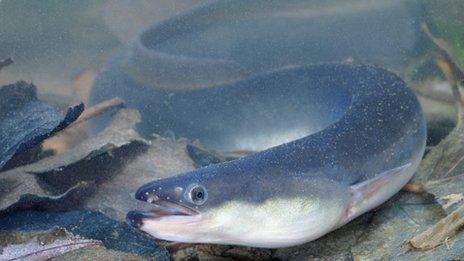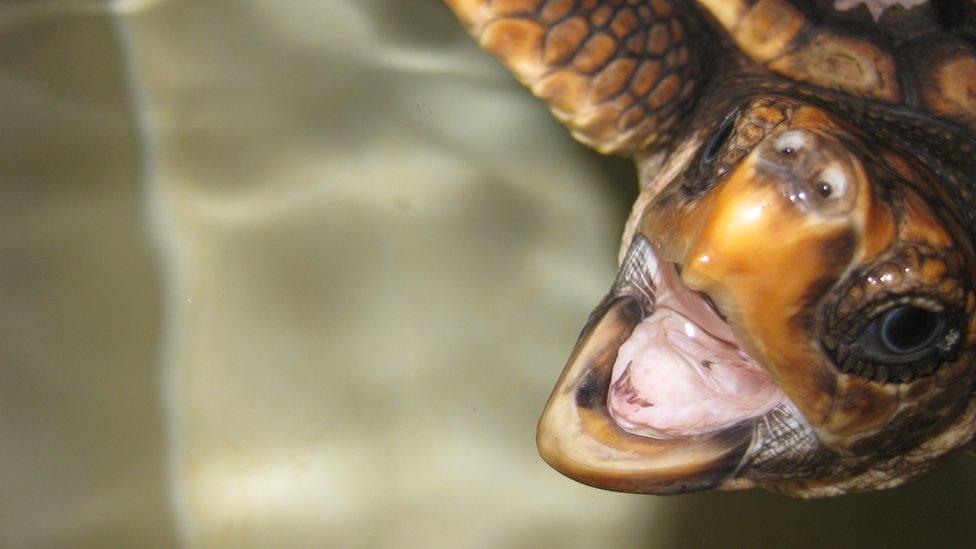Satellites track turtle 'lost years'
- Published
.jpg)
Getting tags to stay on fast-growing young turtles has been a challenge
New insights have been gained into the "lost years" of loggerhead turtles.
Tiny satellite tags have tracked months-old animals in the uncertain period when they leave US coastal waters and head out into the wider Atlantic Ocean.
The data suggests the loggerheads can spend quite some time in the Sargasso Sea, possibly living in amongst floating mats of sargassum seaweed.
The observations are reported in a journal of the Royal Society, external.
“This has been a fun study because the data suggest the turtles are doing something a little bit unexpected to what everyone had assumed over the past few decades, and it boils down to having the right technology to be able to follow the animals,” said lead author Dr Kate Mansfield from University of Central Florida, Orlando.
Scientists have long struggled to track the earliest years of Atlantic loggerheads (Caretta caretta).
After emerging from their nests on Florida’s beaches, the infant turtles, or neonates, make a dash for the water and head out on a great adventure.
Precisely where they go and what they do with their time before returning as large juveniles to the US seaboard has been something of a mystery.
Genetics studies, bycatch, strandings and opportunistic sightings offshore have given broad hints – that they travel in a huge circle within the currents associated with the North Atlantic subtropical gyre, reaching the Azores and Cape Verde before heading back to the Gulf of Mexico and Florida.
Tracking by satellite would give more definitive answers. However, attaching data tags to turtles that are just a few months old, and growing rapidly, is very tricky.
But by using flexible mounts and preparation techniques usually found in a manicurist’s salon, Dr Mansfield’s team got the tags to stay on the animals’ shells for up to 220 days.
And it is with this new data that the scientists can see the young turtles dropping out of the gyre’s predominant currents into the middle of the Atlantic – into what is often referred to as the Sargasso Sea.
The way the tags worked indicated also that the loggerheads mostly stayed at the sea surface. This could be seen in the temperature recordings as well, although these readings were quite a bit higher than expected.

The turtles in this study were released off the US East Coast

The young turtles probably get a warming benefit from associating with sargassum
This has led the team to hypothesise that the turtles are living in and around the great mats of sargassum found in the central Atlantic.
The activity is well known and assumed in young turtles to have something to do with the protection from predation and foraging opportunities that the seaweed offers.
But Dr Mansfield believes there may be thermal benefits for these cold-blooded creatures, too.
“Their survival, their metabolism, their feeding behaviour – everything is enhanced by optimal temperatures. And the sargassum is almost like a warm, floating micro-habitat. The mats trap water where you can get localised warming,” she told BBC News.
“We actually did a down-and-dirty experiment with sargassum in a bucket of water alongside a water bucket without sargassum, and, sure enough, you get a temperature difference that could explain what we saw from the tags.”
Atlantic loggerheads are classified as endangered, and that concern is heightened because they take so long to reach sexual maturity.
It can be 25 years or more before they get to reproduce and put back into the population.
Knowing what they get up to during their juvenile phases is therefore very useful conservation information.
The new study appears in the journal Proceedings of the Royal Society B, external.
Prof Brendan Godley is a co-ordinator of the Marine Turtle Research Group, external, which is based at Exeter University, UK. He commented: "This paper marks a major step forward in the development of satellite tracking.
"So far, tracking has focussed on adults, particularly females with few tags on juveniles and a handful on open oceanic life stages.
"This is the first that has tracked turtles so small. Tracking turtles this way is continually offering new insights into the life history patterns of these elusive species, greatly enhancing our ability to improve the conservation of this important animal group," he told BBC News.
Hear more from Kate Mansfield on BBC Radio 4's Inside Science programme with Lucie Green this Thursday at 1630 GMT.

Tracking studies inform conservation efforts

The data indicates the young turtles stayed close to the surface
All images by Jim Abernethy (NMFS permit 1551).
- Published27 December 2013

- Published27 June 2012
